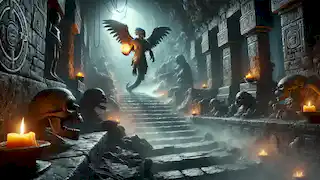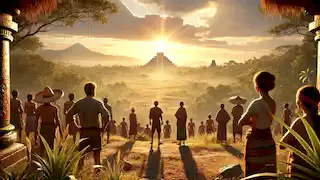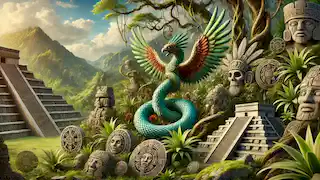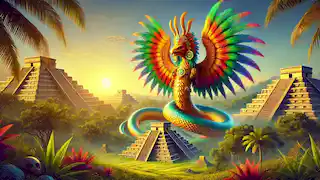Introduction
In the annals of ancient Mesoamerican mythology, few deities are as revered and multifaceted as Quetzalcoatl, the Feathered Serpent. His name alone evokes a powerful blend of strength and divinity, with "Quetzal" symbolizing the beauty and splendor of the sacred bird and "Coatl" representing the snake, a creature of both earth and sky. Quetzalcoatl was not only a god of wisdom, wind, and creation but also the central figure in numerous legends that speak to the origins of humanity, the rise of civilizations, and the cycles of time. The story of Quetzalcoatl is as ancient as the civilizations that flourished in Mexico, from the Olmecs to the Toltecs, and later, the Aztecs. This tale seeks to bring to life the many facets of Quetzalcoatl's legend, from his creation of humankind to his eventual departure from the earthly realm, promising to return one day in a blaze of glory.
Birth of the Feathered Serpent
Long before the world as we know it existed, in the primordial darkness of the universe, the gods gathered in Teotihuacan, the city of the gods. The universe had seen the creation and destruction of several suns, and now, it was time to create the Fifth Sun, the one that would sustain humanity. But the gods knew that the creation of the new sun required great sacrifice. Two gods, Tecuciztecatl and Nanahuatzin, stepped forward to offer themselves in the ultimate act of sacrifice. Nanahuatzin, the humble god, threw himself into the great fire, becoming the Sun. Tecuciztecatl, though braver in appearance, hesitated and followed only after, becoming the moon.
However, the world needed more than just the sun and moon—it needed life. From the cosmic darkness, a new god emerged. This was Quetzalcoatl, the Feathered Serpent, born from the union of sky and earth. His essence was that of air and spirit, and his serpent form symbolized the connection between the heavens and the terrestrial world.
Quetzalcoatl took upon himself the role of creator. But to bring life into the world, he needed the bones of the ancestors. These bones lay hidden in the underworld, guarded by Mictlantecuhtli, the god of death.
Journey to the Underworld
Quetzalcoatl, knowing the importance of his task, ventured into Mictlan, the underworld, in search of the sacred bones. The underworld was a place of perpetual darkness, filled with treacherous paths, and guarded by malevolent spirits. Mictlantecuhtli, who ruled this realm, was not eager to give up the bones. He was cunning, and although he pretended to help Quetzalcoatl, he secretly devised a plan to trick him.

With courage in his heart, Quetzalcoatl pressed forward. After many trials, he reached the resting place of the bones. But just as he prepared to take them, Mictlantecuhtli sent his minions to thwart him. Quetzalcoatl, however, had anticipated this and cleverly evaded their traps. As he fled from the underworld with the bones, he stumbled and fell, causing the bones to scatter and break into various sizes. This, according to legend, is why humans are of different shapes and heights today.
Returning from Mictlan with the broken bones, Quetzalcoatl mixed them with his own blood, breathing life into them. Thus, humankind was born anew, crafted by the blood of the Feathered Serpent himself.
The Golden Age of Tollan
Quetzalcoatl did not merely create humans and leave them to their fate. He became their guide, their teacher, and their protector. One of his greatest contributions was to the civilization of Tollan (also known as Tula), where he ruled as a wise and benevolent leader. Under his reign, Tollan thrived, becoming a center of culture, art, and knowledge. Quetzalcoatl taught his people the ways of agriculture, the importance of peace, and the art of crafting exquisite works of art.
The Feathered Serpent was not a god who demanded sacrifices of blood and war. Unlike other deities who thrived on the offerings of slain warriors, Quetzalcoatl abhorred such violence. He decreed that the only sacrifices that should be made were those of flowers and butterflies, symbols of life and beauty.
However, the peace of Tollan was not to last. For there were other gods, dark and jealous, who sought to undo Quetzalcoatl’s work. Chief among them was Tezcatlipoca, the Smoking Mirror. Tezcatlipoca resented Quetzalcoatl’s popularity and the prosperity of Tollan. He viewed the Feathered Serpent’s ways as weak, believing that true power came from war and domination.
The Fall of Quetzalcoatl
Tezcatlipoca hatched a plan to discredit Quetzalcoatl and bring about his downfall. He transformed himself into an old man and offered Quetzalcoatl a gift—a potion that he claimed would bring eternal wisdom. Quetzalcoatl, unaware of the deception, drank the potion. However, instead of wisdom, the potion was an intoxicant, and it caused Quetzalcoatl to become disoriented and lose his sense of judgment.
In his stupor, Quetzalcoatl acted shamefully in front of his people. When he awoke and realized what had happened, he was filled with guilt and shame. Believing that he had lost the right to lead, Quetzalcoatl left Tollan in disgrace. His departure marked the end of the Golden Age.

Before he left, Quetzalcoatl burned all his temples and treasures. As the flames rose into the sky, he promised his followers that one day he would return. The image of Quetzalcoatl sailing away on a raft made of serpents, heading toward the eastern horizon, became one of the most enduring images in Mesoamerican mythology.
The Prophecy of Return
With Quetzalcoatl gone, darkness fell upon Tollan. Tezcatlipoca and other gods who thrived on war and sacrifice filled the void left by the Feathered Serpent. The people of Tollan, once prosperous and peaceful, were plunged into chaos. But even in their darkest moments, the followers of Quetzalcoatl held on to a prophecy—that one day, the Feathered Serpent would return, bringing with him a new era of peace and prosperity.

This prophecy endured for centuries, passing down from one generation to the next. When the Aztecs rose to power, they, too, embraced the legend of Quetzalcoatl. But by then, the Aztecs had become a warrior society, and the peaceful teachings of Quetzalcoatl were overshadowed by the bloodlust of their sun god, Huitzilopochtli. However, the promise of Quetzalcoatl’s return lingered in their culture.
In the year 1519, when the Spanish conquistador Hernán Cortés arrived on the shores of Mexico, many believed that this pale-skinned foreigner was the reincarnation of Quetzalcoatl, returning to fulfill his promise. The confusion and anticipation that followed led to the downfall of the Aztec Empire, marking the end of an era.
Legacy of Quetzalcoatl
Though Quetzalcoatl’s followers waited for his physical return, the true legacy of the Feathered Serpent lay not in his prophesied reappearance but in the teachings he left behind. His emphasis on wisdom, peace, and creation over destruction resonated through the ages. Even in times of war and chaos, there were those who remembered his message of compassion and harmony.

Quetzalcoatl’s influence spread beyond the borders of Mexico. His image as the Feathered Serpent became a symbol not only of divinity but of the unity between heaven and earth, spirit and matter. His story is one of cycles—creation, fall, and renewal—echoing the belief in the constant rebirth of the world.
Today, Quetzalcoatl remains an enduring symbol of Mexican heritage and identity. His story continues to be told in various forms, reminding people of a time when gods walked among mortals, shaping the destiny of civilizations. More than just a myth, Quetzalcoatl represents the ideal of a world where wisdom, beauty, and peace reign supreme.
Epilogue: The Eternal Cycle
The story of Quetzalcoatl, like the cycles of the sun that he helped create, is eternal. It speaks not only to the origins of humanity but to the endless possibility of renewal. In every age, in every culture, there is a yearning for a time when peace and prosperity will once again reign. And so, the legend of Quetzalcoatl endures, a beacon of hope for future generations.
In the end, Quetzalcoatl’s promise of return may not have been about a literal arrival, but about the rebirth of his ideals in the hearts of those who seek a better world.



















